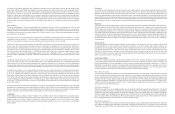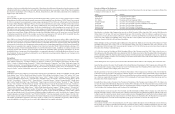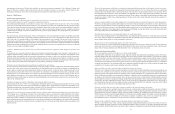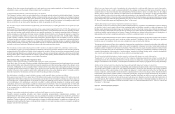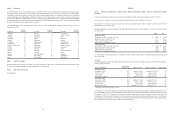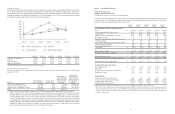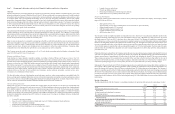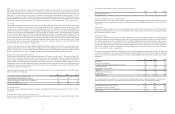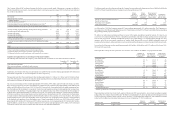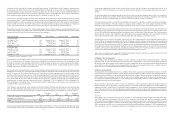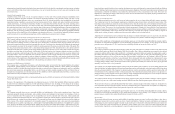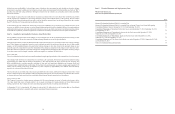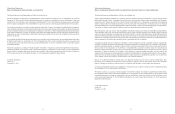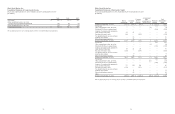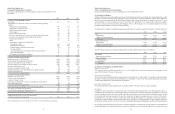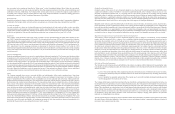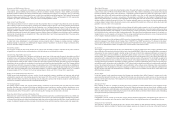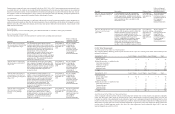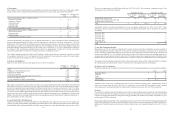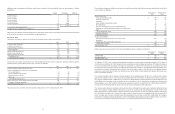Whole Foods 2015 Annual Report Download - page 20
Download and view the complete annual report
Please find page 20 of the 2015 Whole Foods annual report below. You can navigate through the pages in the report by either clicking on the pages listed below, or by using the keyword search tool below to find specific information within the annual report.27
adjustment is principally determined using the item cost method, which is calculated by counting each item in inventory, assigning
costs to each of these items based on the actual purchase cost (net of vendor allowances) of each item and recording the actual
cost of items sold.
Goodwill and Intangible Assets
Goodwill consists of the excess of cost of acquired enterprises over the sum of the amounts assigned to identifiable assets
acquired less liabilities assumed. Goodwill is reviewed for impairment annually at the Company’s fiscal year end, or more
frequently if impairment indicators arise, on a reporting unit level. We allocate goodwill to one reporting unit for goodwill
impairment testing. A qualitative assessment, based on macroeconomic factors, industry and market conditions and company-
specific performance, is performed to determine whether it is more likely than not that the fair value of the reporting unit is
impaired. If it is more likely than not, we compare our fair value, which is determined utilizing both a market value method and
discounted projected future cash flows, to our carrying value for the purpose of identifying impairment. Our annual impairment
review requires extensive use of accounting judgment and financial estimates. Application of alternative assumptions and
definitions, such as reviewing goodwill for impairment at a different organizational level, could produce significantly different
results. Because of the significance of the judgments and estimation processes, it is possible that materially different amounts
could be recorded if we used different assumptions or if the underlying circumstances were to change.
Impairment of Long-Lived Assets and Long-Lived Assets to be Disposed of
The Company evaluates long-lived assets for impairment whenever events or changes in circumstances, such as unplanned
negative cash flow, short lease life, or a plan to close is established, indicate that the carrying amount of an asset may not be
recoverable. Recoverability of assets to be held and used is measured by a comparison of the carrying amount of an asset to
future undiscounted cash flows expected to be generated by the asset. If such assets are determined to be impaired, the impairment
to be recognized is measured by the amount by which the carrying amount of the assets exceeds the fair value of the assets. The
fair value, based on hierarchy input Level 3, is determined using management’s best estimate based on a discounted cash flow
model based on future store operating results using internal projections or based on a review of the future benefit the Company
anticipates receiving from the related assets. Additionally for closing locations, the Company estimates net future cash flows
based on its experience and knowledge of the area in which the closed property is located and, when necessary, utilizes local
real estate brokers. Assets to be disposed of are reported at the lower of the carrying amount or fair value less costs to sell.
Application of alternative assumptions, such as changes in estimates of future cash flows, could produce significantly different
results. Because of the significance of the judgments and estimation processes, it is likely that materially different amounts could
be recorded if we used different assumptions or if the underlying circumstances were to change.
Insurance and Self-Insurance Liabilities
The Company uses a combination of insurance and self-insurance plans to provide for the potential liabilities for workers’
compensation, general liability, property insurance, director and officers’ liability insurance, vehicle liability, and employee
health care benefits. Liabilities associated with the risks that are retained by the Company are estimated, in part, by considering
historical claims experience, demographic factors, severity factors and other actuarial assumptions. While we believe that our
assumptions are appropriate, the estimated accruals for these liabilities could be significantly affected if future occurrences and
claims differ from these assumptions and historical trends.
We have not made any changes in the accounting methodology used to establish our insurance and self-insured liabilities during
the past three fiscal years.
Because of the significance of the judgments and estimation processes, it is likely that materially different amounts could be
recorded if we used different assumptions or if the underlying circumstances were to change. A 10% change in our insurance
and self-insured liabilities at September 27, 2015 would have affected net income by approximately $10 million for fiscal year
2015.
Leases
The Company generally leases stores, non-retail facilities and administrative offices under operating leases. Store lease
agreements generally include rent holidays, rent escalation clauses and contingent rent provisions for percentage of sales in
excess of specified levels. We recognize rent on a straight-line basis over the expected term of the lease, which includes rent
holiday periods and scheduled rent increases. The expected lease term begins with the date the Company has the right to possess
the leased space for construction and other purposes. The expected lease term may also include the exercise of renewal options
if the exercise of the option is determined to be reasonably assured. The expected lease term is also used in the determination
of whether a store is a capital or operating lease. Amortization of land and building under capital lease is included with occupancy
costs, while the amortization of equipment under capital lease is included with depreciation expense. Additionally, we review
leases for which we are involved in construction to determine whether build-to-suit and sale-leaseback criteria are met. For those
28
leases that trigger specific build-to-suit accounting, developer assets are recorded during the construction period with an offsetting
liability. Sale-leaseback transactions are recorded as financing lease obligations. We record tenant improvement allowances and
rent holidays as deferred rent liabilities, and amortize the deferred rent over the expected lease term to rent. We record rent
liabilities for contingent percentage of sales lease provisions when we determine that it is probable that the specified levels as
defined by the lease will be reached.
Reserves for Closed Properties
The Company maintains reserves for retail stores and other properties that are no longer being utilized in current operations.
The Company provides for closed property operating lease liabilities using a discount rate to calculate the present value of the
remaining noncancelable lease payments and lease termination fees after the closing date, net of estimated subtenant income.
The closed property lease liabilities are expected to be paid over the remaining lease terms, which generally range from three
months to 9 years. The reserves for closed properties include management’s estimates for lease subsidies, lease terminations
and future payments on exited real estate. The Company estimates subtenant income and future cash flows based on the Company’s
experience and knowledge of the area in which the closed property is located, the Company’s previous efforts to dispose of
similar assets, existing economic conditions and when necessary utilizes local real estate brokers.
Adjustments to closed property reserves primarily relate to changes in estimated subtenant income or actual exit costs differing
from original estimates. Adjustments are made for changes in estimates in the period in which the changes become known.
Because of the significance of the judgments and estimation processes, it is likely that materially different amounts could be
recorded if we used different assumptions or if the underlying circumstances were to change. A 10% change in our closed
property reserves at September 27, 2015 would not have materially affected net income for fiscal year 2015.
Share-Based Payments
The Company maintains several share-based incentive plans. We grant both options to purchase common stock and restricted
common stock under our Whole Foods Market 2009 Stock Incentive Plan. Options outstanding are governed by the original
terms and conditions of the grants, unless modified by a subsequent agreement. Options are granted at an option price equal to
the market value of the stock at the grant date and generally vest ratably over a four- or nine-year period beginning one year
from grant date and have a five, seven or ten year term. The grant date is established once the Company’s Board of Directors
approves the grant and all key terms have been determined. Stock option grant terms and conditions are communicated to team
members within a relatively short period of time. Our Company generally approves one primary stock option grant annually,
occurring during a trading window. Restricted common stock is granted at the market price of the stock on the day of grant and
generally vests over a four- or six-year period.
The Company uses the Black-Scholes multiple option pricing model which requires extensive use of accounting judgment and
financial estimates, including estimates of the expected term team members will retain their vested stock options before exercising
them, the estimated volatility of the Company’s common stock price over the expected term, and the number of options that will
be forfeited prior to the completion of their vesting requirements. The related share-based payment expense is recognized on a
straight-line basis over the requisite service period. The tax savings resulting from tax deductions in excess of expense reflected
in the Company’s financial statements are reflected as a financing cash flow.
The Company intends to keep its broad-based stock option program in place, but also intends to limit the number of shares
granted in any one year so that annual earnings per share dilution from share-based payment expense will not exceed 10%.
We do not believe there is a reasonable likelihood that there will be a material change in the future estimates or assumptions we
use to determine share-based payment expense. However, if actual results are not consistent with our estimates or assumptions,
we may be exposed to changes in share-based payment expense that could be material.
Because of the significance of the judgments and estimation processes, it is likely that materially different amounts could be
recorded if we used different assumptions or if the underlying circumstances were to change. A 10% change in our share-based
payment expense would not have materially affected net income for fiscal year 2015.
Income Taxes
We recognize deferred income tax assets and liabilities by applying statutory tax rates in effect at the balance sheet date to
differences between the book basis and the tax basis of assets and liabilities. Deferred tax assets and liabilities are measured
using enacted tax rates expected to apply to taxable income in the years in which those temporary differences are expected to
reverse. Deferred tax assets and liabilities are adjusted to reflect changes in tax laws or rates in the period that includes the
enactment date. Significant accounting judgment is required in determining the provision for income taxes and related accruals,


